2. Champagne would be murky and yeasty if a brave woman hadn’t invented a way to get the yeast out.

When Madame Clicquot took over her husband’s Champagne house after his death (hence the name Veuve, or “widow”) Clicquot, she became the first woman to take charge of one—but to say she rose to the occasion would be an understatement. One of her great contributions to the Champagne world was to invent a riddling rack.
After Champagne is fermented once in barrels, it’s bottled and yeast is added for its second fermentation. The yeast eats the sugar, which causes Champagne’s famous effervescence, but a lot of dead yeast are left behind at the bottom of the bottle. Clicquot’s solution was to create a rack that puts the bottles at an angle, cork-side down, so that the yeast falls into the neck of the bottle in roughly two weeks and becomes a compact and easily-removable puck of yeast. Today, many houses do this process with machinery called a gyropallette, but Clicquot's method lasted for hundreds of years and is responsible for Champagne’s clarity.
[Photo via @veuveclicquot]


.jpg)
.jpg)



.jpg)
.jpg)
.jpg)




